In recent months, MCI has introduced or announced several new models and product enhancements. Noteworthy is the revolutionary new D45 CRT LE Commuter Coach that offers a low entry for those using wheelchairs and mobility devices. The popular J4500 coach, already upgraded for 2018, is receiving several additional improvements for 2019. In addition, a battery-electric version of the J4500, known as the J4500e CHARGE, is already in the testing stage.
Another new model that is joining the MCI product line is the 35-foot J3500. Effectively a shorter sibling to the J4500, the J3500 offers all of the big coach amenities and features for smaller groups. While the J3500 offers several features and advantages, two are noteworthy. Unlike the body-on-chassis buses, the J3500 is integral and has the durability as well as passenger comfort and amenities like the big coaches. Hence, you can send it out on the highway and on longer charters and tours. Being based on the 45-foot J4500, the J3500 not only makes driver transition easy but also requires little change for technicians and reduces parts inventory. Heritage This new J3500 has an interesting heritage. Back in the late 1990s, MCI was offering their “D” model in both 40-foot and 45-foot lengths. The latest model in a constantly improving product line, the D coaches continued to be built in the old platform integral way as originally developed by MCI founder Harry Zoltok. The “D” coach and its older siblings gave MCI its reputation for durability and reliability.
Several MCI customers approached the company and asked whether it would be possible to take this heritage of reliability and durability but put it into an attractive package that would turn heads in the tour and upscale charter business. MCI’s engineers complied and developed what became the “E” model or Renaissance coach. Introduced in 1998, it offered a radical new style and several upscale features that made it an excellent addition to the product line and a compliment to the “D” models. While the “D” models continued as the undisputed leader in scheduled service, commuter coaches and reliability, the new “E” model Renaissance provided similar features in a more attractive package for tours and upscale charters.
Expectedly, there were several MCI customers who liked the design and appearance of the new “E” model, but had an interest in matching that modern and attractive appearance with more of a “bread and butter” type coach. Once again, the MCI engineers retired to their drawingboards to address customer needs. This time they came up with the J4500 model. Introduced in 2001, it offered the attractive design of the “E” model but was more of a “jack of all trades.”
This universal appeal was soon obvious. Peter Pan put the J4500 into scheduled service while other operators sent it out on charters and higher quality tours. By 2004, the J4500 became the most popular coach on the market, a record it has kept in subsequent years. What makes the J4500 so unique is that the MCI engineers kept on working on enhancements and improvements every year or two. Before long, the J4500 had replaced the “E” model. There were a substantial number of improvements in 2018 and more again in 2019.
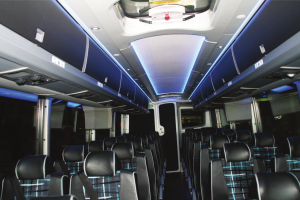 Meanwhile, MCI operators were looking for a higher quality coach for smaller groups. While body-on-chassis and cutaway buses were practical for shuttle service and short runs, many operators were seeking a smaller coach suitable for long distance charters and tours with underfloor luggage space, air ride suspension and all of the passenger amenities offered by the larger coaches.
Meanwhile, MCI operators were looking for a higher quality coach for smaller groups. While body-on-chassis and cutaway buses were practical for shuttle service and short runs, many operators were seeking a smaller coach suitable for long distance charters and tours with underfloor luggage space, air ride suspension and all of the passenger amenities offered by the larger coaches.
As a result, MCI’s engineers came up with the J3500 model. It is effectively a 35-foot version of the J4500. Hence, it offers the features of the most popular coach on the market but in a 10-foot shorter length for smaller groups. This introduction is more of a milestone in our market than most people might think. While Eagle built a handful of 35-foot coaches at Brownsville and Neoplan did produce a few at Lamar, the last real ongoing regular production of a 35-foot coach in the United States and Canada goes back to 1980. It was then that MCI discontinued its MC-5C model. Hence, we are talking about a gap of about 38 years.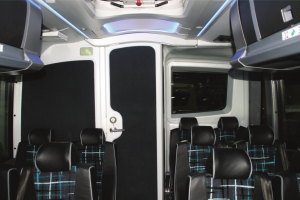
Similar Yet Different
The first question most people ask is how similar is the J3500 to the ever-popular J4500? What has been left out? What items are missing?
In general, MCI went though a lot of trouble to make the J3500 as similar and as compatible with the J4500 as possible. While they look different from the side, if you look at them head-on, you may not be able to tell them apart. Drivers should have no difficulty transitioning to the J3500 from the J4500 because the cockpits are essentially the same. While there are changes in the engine compartment (the J3500 does have a smaller engine), your service staff and technicians will be very familiar with the setup and appreciate the spacious engine bay area that improves maintenance access. In addition, you will find that the majority of J3500 parts are the same as for the J4500, so there are a minimum number of unique parts that need to be stocked for the J3500.
The differences in the J3500 are exactly where you would expect them – related to length and capacity. With a length of 35 feet, the J3500 is 10 feet shorter than the J4500. Hence, the J3500 has only two axles while the J4500 has three. Nominal passenger capacity on the shorter coach is 40 or 44, with good legroom like the longer coach.
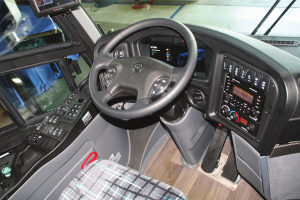 Other noteworthy differences include the fact that the J3500 has a turning radius of less than 33 feet. Hence, it is very maneuverable in tight spaces and an excellent choice where getting in and getting around matters. The wheelbase on the 35-foot coach is 228.8 inches compared with 315 inches in the 45-foot coach. You get a slightly smaller fuel tank with the J3500, 164 gallons, as compared with the 183-gallon tank on the J4500. Luggage capacity on the J3500 is 285 cubic feet without a lift and 270 cubic feet with the wheelchair lift.
Other noteworthy differences include the fact that the J3500 has a turning radius of less than 33 feet. Hence, it is very maneuverable in tight spaces and an excellent choice where getting in and getting around matters. The wheelbase on the 35-foot coach is 228.8 inches compared with 315 inches in the 45-foot coach. You get a slightly smaller fuel tank with the J3500, 164 gallons, as compared with the 183-gallon tank on the J4500. Luggage capacity on the J3500 is 285 cubic feet without a lift and 270 cubic feet with the wheelchair lift.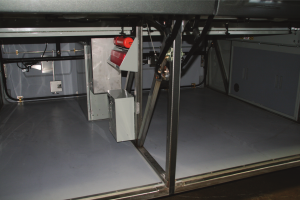
The front overhang on both models is the same at 78.25 inches while the rear overhang on the J3500 is only 120.29 inches compared with 150.25 inches on the longer coach. Many of the other specs are the same for both models: a width of 102 inches, a height of 140.75 inches (about 11 feet and 8 inches), and an interior height of 78.25 inches.
Perhaps the single biggest difference is that the J3500 comes with the smaller 2017 EPA Cummins L9 350 horsepower engine. Having ridden on a pilot model of the J3500, I tend to feel that this engine is more than adequate. As a past owner and driver of an MCI MC-5A with the 8V-71 engine rated at 318 horsepower, I think that the Cummins L9 in the J3500 will do fine. The L9 setup in the new J3500 also benefits from a simplified single module aftertreatment system.
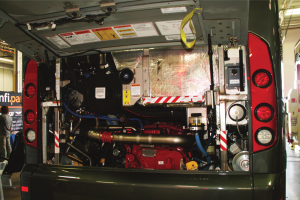 Beyond this, it is obvious that MCI is not cutting back on amenities or features in the J3500. As a general rule, whatever comes with the J4500 will come with the J3500 and whatever is an option on the J4500 will be an option on the J3500. All of those interesting features that were added to the J4500 for 2018 will be on the J3500 coaches as they come off the line.
Beyond this, it is obvious that MCI is not cutting back on amenities or features in the J3500. As a general rule, whatever comes with the J4500 will come with the J3500 and whatever is an option on the J4500 will be an option on the J3500. All of those interesting features that were added to the J4500 for 2018 will be on the J3500 coaches as they come off the line.
This would include the redesigned engine air intake system and engine compartment as well as the newly redesigned restroom. You will find the improved passenger area with coordinated interior trim packages and multi-color interior programmable lighting. Also included are the improvements in the front stepwell and driver’s area.
New Features
New features being added to the J4500 will also be on the new J3500 coaches when they come off the assembly line. The first pilot models of the J3500 had the traditional cooling fans. However, as they are put into regular production, the J3500 coaches will come off the line with the new electronically controlled e-fan system and swing-out radiator. MCI notes its new swing-out cooling module e-Fan system improves coach reliability and fuel economy while drastically reducing the time required for service to after treatment sensors and all “hot side” engine components.
The production J3500 coaches will also likely include the optional Bendix® Wingman® Fusion™ system that will be available with the 2019 models of the J4500. This system gathers input from radar, video and the braking system to create a highly detailed and accurate data picture on bus operations and the area surrounding the bus. Data comes in from the next-generation radar, camera and brake systems. This is constantly being gathered, shared and confirmed by the system to see what actions are called for, with the main functionality including enhance collision mitigation with the ability to stop the coach when a stationary vehicle is detected, adaptive cruise control with braking, lane departure warnings and traffic sign recognition, all integrated into MCI’s high definition instrument panel for ease of visibility for the driver.
This new system does incorporate the Bendix ESP® Electronic Stability program full-stability system. Plus it has the AutoVue® Lane Departure Warning System from Bendix CVS. It also has the Bendix Wingman Advanced™ Collision Mitigation Technology.
New features include Stationary Vehicle Braking (SVB) that uses data from both radar and a camera to watch the road ahead. When a stationary metallic object is identified in the path of the bus, the driver is given a warning. If the driver fails to take action, Wingman Fusion can automatically engage the brakes to assist the driver in reducing the severity of the impact or avoiding a collision.
Yet another new feature of Wingman Fusion is that the camera can read speed limit signs along the road. When the bus is moving at more than 20 miles per hour, the system can compare the speed limit signs with the actual bus speed. If the driver is operating five miles per hour above the posted speed an audible warning will sound. At 10 miles per hour above the posted speed, the system will provide a one-second dethrottle of the engine to get the driver’s attention.
Production and an Electric Model
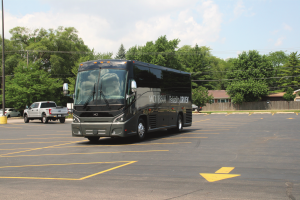 MCI is already taking orders for the J3500. Current plans are to have the J3500 coaches in regular production in early 2019 with the first deliveries soon afterward.
MCI is already taking orders for the J3500. Current plans are to have the J3500 coaches in regular production in early 2019 with the first deliveries soon afterward.
Like the battery-electric J4500e CHARGE, a battery-electric version of the J3500 is contemplated for the future. The reduced length and high maneuverability of the J3500 will make the battery-electric version an excellent choice for many shuttle operations and possibly for local sightseeing.

